The moon isn't the only body out in space that produces human cycles. The sun, the basic source of all life on earth, has its own rhythm, which produces cycles in humans and non-humans alike. Since the 1800s astronomers have noted that there is an eleven and a twenty-two-year sunspot cycle; that is, for some years there would be hardly any sunspots, and then for some years the sun's face would be as blotchy as a teenager with acne. It wasn't until the 1930s, however, that it occurred to anyone that something going on that far away from earth could affect us.
Sunspot Cycles and Activity Affects Human Endeavors
During the sunspot peak of the 1930s, Dr. Miki Takata found that human blood serum was affected by the solar radiation put out by sunspots. During the same period it was discovered that sunspot emissions affected a wide variety of other things, such as the size of tree rings and the amount of radio interference on certain bandwidths.
During World War II, the potential communications blackout that sunspots and solar storms might cause was of great concern to the armed forces, so a radio engineer at RCA named John Nelson was asked to come up with a method of predicting when the storms would occur. Nelson figured that the only major variables that might conceivably affect the sun's turbulent surface were the planets surrounding it. He devised a system of charting their relationships to the sun and to one another and found that when certain angular relationships between planets occurred, sunspots and solar magnetic storms broke out. To date, his system of prediction has been 95 percent accurate, and the hypothesis that the planets cause solar 'tides' was proved by Professor K. D. Wood at the University of Colorado.
Sunspot Cycles And Weather Patterns
More recently, many scientists have been suggesting that the sunspot cycle is critical in the formation of our weather patterns. Indeed, during a seventy-year period in the seventeenth and eighteenth centuries when the cycle was interrupted and sunspots stopped for no apparent reason, Europe was plunged into its coldest period on record, nicknamed the 'Little Ice Age'. Astronomer John R. Gribbin and astrophysicist Stephen H. Plagemann even speculated that sunspot and planetary cycles are linked to earthquakes, and a future unusual planetary alignment may trigger a devastating California quake. The more the subject is investigated, the more important these cycles appear.
Sunspot Activity Predicting Wars, Uprisings, And Protest
The amount of solar radiation we receive, which is determined by the sunspot cycle, may have profound historical significance. Soviet professor A. C. Tchyivsky has correlated the eleven-year cycle with what he calls a worldwide 'mass excitement cycle'. He found that throughout history events such as wars, migrations, crusades, uprisings, and revolutions have clustered around peak sunspot periods. In the three years surrounding these peaks 60 percent of such events occurred, while only 5 percent occurred in the troughs. It would appear that tides govern the affairs of nations as well as individuals.
But can planetary cycles directly affect individual human events? If the answer is yes, then cycle research begins to look pretty much like astrology, a subject most scientists aren't too fond of.
Do More Accident Occur During Increased Sunspot Activity?
An Atomic Energy Commission-funded project at Sandia Laboratories in Albuquerque, New Mexico, came up with a report entitled 'Intriguing Accident Patterns Plotted against a Background of Natural Environmental Features', which correlated on-the-job accidents of government employees over a period of 20 years with various natural cycles. This preliminary report (the researchers suggested further study was in order) found that accidents peak with the sunspot cycle and -- even more intriguing and 'astrological' -- that people were more likely to have accidents during the phase of the moon the same as or opposite to that under which they were born.
Some really hard and startling evidence might have come out of this research had it been allowed to continue. But alas, that was not to be. Shortly after its completion, the report fell into the hands of Time magazine, which did a spoof on it in its January 10, 1972, issue, under the heading 'Moonstruck Scientists', complete with an old woodcut of maidens dancing in a frenzy under the rays of the full moon.
That was all the Congress needed to kill the project and suppress the report. When I wrote to the Atomic Energy Commission and Sandia in 1972, I was told that the report was not for distribution and that I, or any other taxpayer, could not see it. The report remained classified until 1977, when I again requested a copy, this time under the provisions of the Freedom of Information Act. At first, I was told that all extant copies had been lost, hut through the efforts of a persistent Energy Research Administration officer, Sandia was finally pressured into coughing up a copy -- accompanied by a somewhat terrified disclaimer telling me I really shouldn't believe what was in it.
J. E. Davidson, who wrote the report with a team of fellow scientists, told me over the phone that he was sad the research had been canceled. The team felt they were on to something and, except for a nosy journalist and premature publicity, might have made a significant contribution to cycle research. Instead, their work was thrown down the drain. But that's the breaks when Congress is your boss.
Some Researchers Have Found Correlations between Activity And Human Behavior
Probably the most distinguished work connecting planetary cycles with events and trends in the lives of individuals has been that of French psychologist and statistician Michel Gauquelin. In the mid-1960s he set out to disprove astrology statistically by analyzing planetary positions at the births of professionals, using samples as large as 10,000, 15,000, and 20,000. Astrologers have always believed that certain planets coming up over the horizon, or directly overhead at a person's birth, guide that individual toward a certain profession.
To Gauquelin, the task he had set for himself seemed like a piece of cake. All he had to do was prove that the planet associated with athletic achievement, Mars, fell at random points in the nativities of 10,000 or 15,000 athletes, and that would be that -- astrology would be debunked. To emphasize his point he also investigated groups of doctors, lawyers, writers, and others in jobs associated by astrologers with specific planets.
To Gauquelin's surprise, the results turned out to be exactly the opposite of what he had expected. Mars did appear to be rising or culminating in a vast number of athletes' birth charts. Similarly, Jupiter appeared for bankers, Saturn for doctors, Mercury for writers, and so on. Gauquelin was astounded. Had he accidentally proved the case for astrology when he had meant to debunk it?
Actually, he had done a lot more than that because his data not only confirmed traditional astrological assignments, they uncovered new ones. For writers, for instance, the traditionally associated planet is Mercury. Gauquelin found that Mercury was indeed significant in writers' natal charts, but he also found that the moon was equally important, something astrologers had never posited.
Gauquelin's work established the fact that planetary positions do affect human disposition, talent, and direction and that these effects can be specifically determined by scientific methods such as statistical analysis and probability.
 This article was excerpted from the book:
This article was excerpted from the book:
Dynamic Astrology: Using Planetary Cycles to Make Personal and Career Choices, ©1997,
by John Townley.
Reprinted with permission of Destiny Books an imprint of Inner Traditions, Rochester, Vermont, USA. www.innertraditions.com
Info or Order this book.
About The Author
John Townley is a lifelong astrologer, author, composer, and historian. His professional experience has spanned the fields of business, science, journalism, maritime history, and the creative arts. He may be reached at






























